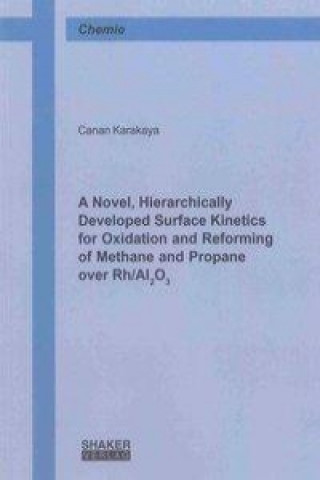
Kód: 12709542
A Novel, Hierarchically Developed Surface Kinetics for Oxidation and Reforming of Methane and Propane over Rh/Al2O3
Autor Canan Karakaya
This thesis focuses on the development of a surface reaction mechanism for oxidation of H2 and CO, water-gas shift (WGS) as well as reverse water-gas shift (R-WGS) reactions and partial/total oxidation and steam/dry reforming of m ... celý popis
- Jazyk:
 Angličtina
Angličtina - Vazba: Brožovaná
- Počet stran: 184
Nakladatelství: Shaker Verlag, 2013
- Více informací o knize

Mohlo by se vám také líbit
-

Dune
216 Kč -

Haunting Adeline
621 Kč -

Berserk Deluxe Volume 2
1092 Kč -

White Nights
89 Kč -

Powerless
268 Kč -

Atomic Habits
330 Kč -

Dune Messiah
228 Kč -

Berserk Deluxe Volume 3
1142 Kč -

One Day
221 Kč -

Berserk Deluxe Volume 1
1115 Kč -

Iron Flame
368 Kč -

Surrounded by Idiots
213 Kč -

Harry Potter and the Prisoner of Azkaban (Minalima Edition)
993 Kč -

Gravity Falls Journal 3
443 Kč -

Heaven Official's Blessing: Tian Guan Ci Fu (Novel) Vol. 1
440 Kč -

The Creative Act
568 Kč -

Dune
276 Kč -

Hunting Adeline
624 Kč -

A Little Life
290 Kč -

Children of Dune
230 Kč -

Heaven Official's Blessing: Tian Guan Ci Fu (Novel) Vol. 2
427 Kč
Informovat o naskladnění knihy
Zadejte do formuláře e-mailovou adresu a jakmile knihu naskladníme, zašleme vám o tom zprávu. Pohlídáme vše za vás.
Více informací o knize A Novel, Hierarchically Developed Surface Kinetics for Oxidation and Reforming of Methane and Propane over Rh/Al2O3
 Anotace knihy
Anotace knihy
This thesis focuses on the development of a surface reaction mechanism for oxidation of H2 and CO, water-gas shift (WGS) as well as reverse water-gas shift (R-WGS) reactions and partial/total oxidation and steam/dry reforming of methane and propane over Rh/Al2O3 catalyst. The study aims at providing a better understanding of the reaction kinetics of synthesis gas production. A stagnation-flow reactor set-up has been developed and constructed to study the reaction kinetics of various gas fuels (e.g., H2, CO, CH4, C2H6, C3H8) and evaporated liquids (e.g., water, ethanol, methanol, iso-octane). The reactor configuration facilitates one-dimensional (1D) modeling of coupled diffusive and convective transport within the gas-phase boundary layer with detailed heterogeneous chemistry model. As a result, well-defined boundary conditions are created, and heat and mass transport effects are eliminated from the kinetic model. Boundary-layer composition profiles of the species are measured by using a micro-probe sampling technique. Gas-phase concentrations of the species are simultaneously analyzed by MS and FTIR. The stagnation disk is coated with a Rh/Al2O3 catalyst by spin-spray technique. Light microscopy (LM), scanning electron microscopy (SEM), and transmission electron microscopy (TEM) are applied for the determination of the physical properties of the catalyst to reveal the interaction between the support and the active phase. A new CO chemisorption TPD technique is developed for the measurement of the catalytically active surface area of the stagnation disk. The experiments are conducted in the stagnation-flow reactor following a hierarchical approach in the development of suitable kinetic model for oxidation and reforming of light hydrocarbons. All possible reaction paths of partial oxidation and reforming of methane and propane are considered. The complexities of the systems are augmented by increasing the complexity of fuel type and reactant composition. H2 oxidation, CO oxidation, preferential oxidation of CO, WGS, R-WGS, catalytic partial oxidation (CPOx), steam reforming (SR), and dry reforming (DR) of CH4 and C3H8 reactions are investigated. The reactions are examined under varying fuel composition and over a wide range of temperature. For each case, the reaction temperature is chosen so that only heterogeneous reactions occur and that gas-phase reactions can be neglected. Furthermore, ignition studies are conducted to understand the adsorption and desorption behavior of the species (H2, CO, CH4, C2H6 and C3H8). Numerical simulations are performed using the CHEMKIN SPIN and DETCHEMSTAG codes. The obtained data are used to assist in the development of an elementary-step-like surface reaction mechanism based on the mean-field approximation. Thermodynamic consistency is ensured. The applicability of the reaction mechanism is shown by simulation of different continuous-flow reactor models from different research groups using DETCHEMCHANNEL software.
 Parametry knihy
Parametry knihy
- Plný název: A Novel, Hierarchically Developed Surface Kinetics for Oxidation and Reforming of Methane and Propane over Rh/Al2O3
- Autor: Canan Karakaya
- Jazyk:
 Angličtina
Angličtina - Vazba: Brožovaná
- Počet stran: 184
- EAN: 9783844023329
- ISBN: 3844023321
- ID: 12709542
- Nakladatelství: Shaker Verlag
- Hmotnost: 262 g
- Rozměry: 214 × 149 × 17 mm
- Datum vydání: 28. October 2013
Osobní odběr Praha, Brno a 12903 dalších
Copyright ©2008-24 nejlevnejsi-knihy.cz Všechna práva vyhrazenaSoukromíCookies



 Vrácení do měsíce
Vrácení do měsíce 571 999 099 (8-15.30h)
571 999 099 (8-15.30h)